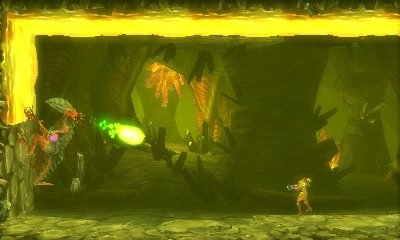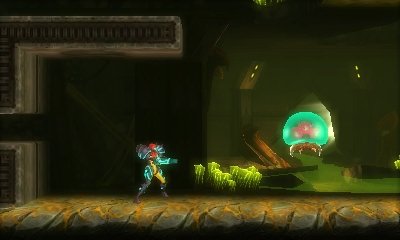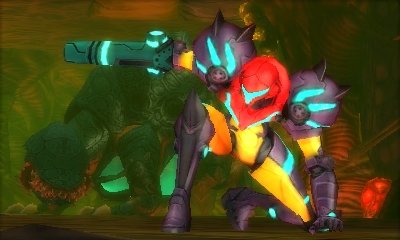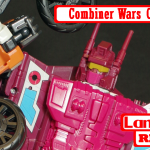The Good
- Solid game play from a solid franchise
- Nice little additions and changes from the original Metroid II
- Good visuals
The Bad
- Repetitive enemies and play mechanics
- Bosses are disproportionately difficult compared to everything else
- Very linear game play for a “Metroidvania” style game.
In Depth
 Metroid: Samus Returns is a 3DS update and remake of the original Metroid II on Game Boy. It’s essentially to Metroid II, what Zero Mission is to the original Metroid. The maps in Samus Returns are a little closer to the original Metroid II maps than Zero Mission and Metroid, but there are some changes and additions. Samus Returns adds Super Missiles and power bombs to Samus’ arsenal, for example, and there is a map revealing scope mechanism as well as the addition fo the Grappling beam. A lot of the added items are things added during Metroid 3, that became regular staples of the series.
Metroid: Samus Returns is a 3DS update and remake of the original Metroid II on Game Boy. It’s essentially to Metroid II, what Zero Mission is to the original Metroid. The maps in Samus Returns are a little closer to the original Metroid II maps than Zero Mission and Metroid, but there are some changes and additions. Samus Returns adds Super Missiles and power bombs to Samus’ arsenal, for example, and there is a map revealing scope mechanism as well as the addition fo the Grappling beam. A lot of the added items are things added during Metroid 3, that became regular staples of the series.
The entire game also has a modern overhaul. Instead of sprites, everything is polygons and the game is playable in 3D mode, though it is a 2D platform title. Only one new boss uses the 3D mechanics in 3D space, everything else operates in classic 2D Metroid style. I really enjoy this style of game, so I am admittedly biased towards the play style. The game is lacking a bit in the Metroidvania department however. A lot of the areas have 2 or 3 main path loops that the player must traverse and there isn’t a lot of backtracking done aside from picking up items later, and a lot of this backtracking needs to be done close to the end of the game since you don’t even find the weapon needed to unlock these items until later in the game. The game itself is broken up into 8 Areas, all generically named “Area”. The Areas are gate blocked by special pedestals that only open the way after collecting a certain number of Metroid DNA samples. There isn’t a lot of explanation to what these pedestals are but it’s most likely Chozo related, in classic Metroid fashion.
 The core of the game is fun, and everything about the remake works well and helps flesh out the game play from the original title. Metroid II has always been one of the weaker titles in the series and fleshing it out and giving it a bit more connection to the world of Metroid at large. Despite taking place on the homeworld of the alien Metroid creatures, it’s always felt a little separated. Partly because even the Metroids themselves are all mutated “mature” versions that don’t fit the usual Bubble with Claws image of what a Metroid is supposed to be.
The core of the game is fun, and everything about the remake works well and helps flesh out the game play from the original title. Metroid II has always been one of the weaker titles in the series and fleshing it out and giving it a bit more connection to the world of Metroid at large. Despite taking place on the homeworld of the alien Metroid creatures, it’s always felt a little separated. Partly because even the Metroids themselves are all mutated “mature” versions that don’t fit the usual Bubble with Claws image of what a Metroid is supposed to be.
Which leads into the core problem with this game, and with Metroid II. The basic plot involves killing Metroids of various types, more powerful than the last, in order to proceed through the game. There are 4 types of Metroids, not counting the Queen, and you fight each type several times. These 40 fights end up being extremely samey as a result. This problem is exacerbated by Alpha and Gamma Metroid being, more or less the same thing and each of the Omega Metroid battles are literally identical. There is some variation in the fights by using different environments, sometimes over lava or damaging plants or around movement hindering water, but they all use the same general mechanics until you each the Omega Metroids. Some of the battles have these moments where the Metroid runs off into a nearby room, which honestly just makes things even more tedious since it mostly just means passing a simple and annoying ball mode tunnel puzzle to progress the fight.
 This repetition in boss fights isn’t helped by the normal level enemies either, there’s something like 6 or 7 different ones in different colors that you face… over… and over… and over… They respawn extremely quickly as well, so sometimes just traveling back and forth a room you get to battle the same enemies over and over. The game also introduces this gimmicky melee counter attack. Enemies will charge you, you counter them, then you effectively one shot them if the counter hits. If you miss, or just try to kill the enemy, you get to shoot it normally, often a dozen or more times. The whole thing is designed around encounter, wait for charge, counter attack, kill, which itself is slow and tedious the 100th time you perform the action.
This repetition in boss fights isn’t helped by the normal level enemies either, there’s something like 6 or 7 different ones in different colors that you face… over… and over… and over… They respawn extremely quickly as well, so sometimes just traveling back and forth a room you get to battle the same enemies over and over. The game also introduces this gimmicky melee counter attack. Enemies will charge you, you counter them, then you effectively one shot them if the counter hits. If you miss, or just try to kill the enemy, you get to shoot it normally, often a dozen or more times. The whole thing is designed around encounter, wait for charge, counter attack, kill, which itself is slow and tedious the 100th time you perform the action.
There is a new boss that’s added to the game that shows up a few times. A large Chozo digging robot pops up early on, awakened by Samus. It later shows up during a stage sequence where you must outrun it’s massive destructive drill arms while passing over and through obstacles. Eventually you battle it out with the boss. It’s probably the most difficult boss in the game, though not the final boss, and it’s a nice change of pace from the repetition of the Metroids.
Despite the repetition, it’s a fun game. It’s not the best Metroid title but it’s a welcome update to one of the less enjoyably and probably less played games int he Metroid franchise. The new additions do a lot of good freshening things up and the updated graphics are a great step up from the cramped old Game Boy title.

